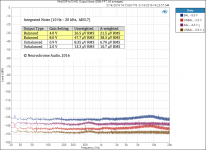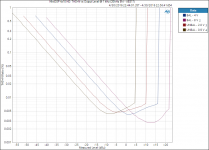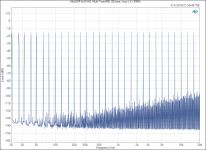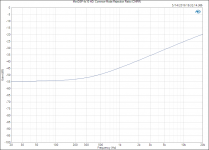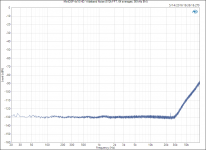Every now and then concerns about the noise level of the MiniDSP balanced output are brought up. As I am considering using the MiniDSP 4x10 HD in my system with a balanced setup, I decided to measure one.
I debated for a while about how to best present the results as there is interest in them both here and on OPLUG. Also, I would prefer that the results can be found easily in the future and forum threads tend to be harder to search. Hence, I have posted the full set of measurements in the Resources section of my website.
I've attached the more exciting plots. The rest can be found on my MiniDSP 4x10 HD Measurements Page: MiniDSP 4x10 HD.
The measurements were performed on my Audio Precision APx525.
Conclusion regarding noise: I would use either the balanced output at the 4.0 V gain setting or the unbalanced output at the 2.0 V gain setting for the best gain structure and SNR. Of the two, my preference is to use balanced interconnects as that architecture moves the ground loop(s) out of the signal path through common-mode rejection.
General conclusion/impressions on the MiniDSP 4x10 HD. At the $500 price point you really get a lot for your money with the MiniDSP 4x10 HD. I do see some room for improvement, in particular in the analog I/O sections and in the software, but I think you get good bang for the buck with this box. In the cosmetic department, it presents nicely on the shelf and I do like the learning feature of the remote control receiver. The MiniDSP 4x10 HD does not come with a remote control but will learn the codes of any remote control using the Philips RC-5, NEC, or Sony RC formats. Those who are into pro audio will like that it comes with rack ears.
Tom
I debated for a while about how to best present the results as there is interest in them both here and on OPLUG. Also, I would prefer that the results can be found easily in the future and forum threads tend to be harder to search. Hence, I have posted the full set of measurements in the Resources section of my website.
I've attached the more exciting plots. The rest can be found on my MiniDSP 4x10 HD Measurements Page: MiniDSP 4x10 HD.
The measurements were performed on my Audio Precision APx525.
Conclusion regarding noise: I would use either the balanced output at the 4.0 V gain setting or the unbalanced output at the 2.0 V gain setting for the best gain structure and SNR. Of the two, my preference is to use balanced interconnects as that architecture moves the ground loop(s) out of the signal path through common-mode rejection.
General conclusion/impressions on the MiniDSP 4x10 HD. At the $500 price point you really get a lot for your money with the MiniDSP 4x10 HD. I do see some room for improvement, in particular in the analog I/O sections and in the software, but I think you get good bang for the buck with this box. In the cosmetic department, it presents nicely on the shelf and I do like the learning feature of the remote control receiver. The MiniDSP 4x10 HD does not come with a remote control but will learn the codes of any remote control using the Philips RC-5, NEC, or Sony RC formats. Those who are into pro audio will like that it comes with rack ears.
Tom
Attachments
Nice set of measurements, and de-angsts me from using the 4v balanced outputs on my 2x8 🙂. Must finish putting it in box...
Did you measure noise above 20kHz? http://www.diyaudio.com/forums/minidsp/290902-need-project-minidsp-10x10-hd.html#post4707878 Davey shows considerable ultrasonic noise in his measurements.
Did you measure noise above 20kHz? http://www.diyaudio.com/forums/minidsp/290902-need-project-minidsp-10x10-hd.html#post4707878 Davey shows considerable ultrasonic noise in his measurements.
Davey just suggested that I take a look at the out-of-band noise. I need to measure the CMRR of the differential inputs as well.
I guess some are concerned with some sort of down-conversion of the ultrasonic noise. If that was the case, we'd have had issues with CD players since the late 1980ies when the delta-sigma converters took hold. Down-conversion also requires a significant nonlinearity to act as a mixer and most audio systems are remarkably linear - in particular compared to mixers.
Without better data, my opinion is that the folks who are concerned with the noise of the MiniDSP are running their DSP into a high-gain power amp. 25 µV into a power amp with 32 dB gain (40x) is 1 mV RMS of noise. Into a 95 dB efficient full-ranger or tweeter that's certainly audible. That's my current, skeptical, guess of why some report noise issues.
Tom
I guess some are concerned with some sort of down-conversion of the ultrasonic noise. If that was the case, we'd have had issues with CD players since the late 1980ies when the delta-sigma converters took hold. Down-conversion also requires a significant nonlinearity to act as a mixer and most audio systems are remarkably linear - in particular compared to mixers.
Without better data, my opinion is that the folks who are concerned with the noise of the MiniDSP are running their DSP into a high-gain power amp. 25 µV into a power amp with 32 dB gain (40x) is 1 mV RMS of noise. Into a 95 dB efficient full-ranger or tweeter that's certainly audible. That's my current, skeptical, guess of why some report noise issues.
Tom
Your last chart shows -85dB hiss like IMD relative to -15dB 2V full spectrum bands signal level. Since many music files have -15dB average as I have seen in Foobar, that level of hiss should be audible at times in high sensitivity speakers on relatively high voltage gain system chains. Maybe like a bit of brightness.
high sensitivity speakers on relatively high voltage gain system chains
Don't do that...problem fixed! 😉
Mike
Your last chart shows -85dB hiss like IMD relative to -15dB 2V full spectrum bands signal level. Since many music files have -15dB average as I have seen in Foobar, that level of hiss should be audible at times in high sensitivity speakers on relatively high voltage gain system chains. Maybe like a bit of brightness.
The last chart is a multi-tone IMD plot. The "hiss" is the IMD, not noise. I think you've misinterpreted the plot, hence, reached the wrong conclusion.
Tom
The CMRR is less than stellar. That's to be expected from a discrete solution, though, it looks like the layout could use some tightening up to prevent the degradation above 1 kHz. Still the CMRR of the MiniDSP 4x10 HD is much better than the 0 dB CMRR of a single-ended solution.
There is some out of band noise from the noise shaping. I'm not surprised. I'm just saying it exists. 🙂 I'm not seeing anything that changes my fundamental conclusion: You get quite a bit for your $500 with the 4x10 HD.
Tom
There is some out of band noise from the noise shaping. I'm not surprised. I'm just saying it exists. 🙂 I'm not seeing anything that changes my fundamental conclusion: You get quite a bit for your $500 with the 4x10 HD.
Tom
Attachments
Don't do that...problem fixed! 😉
Mike
That's why I designed the Modulus-86 with 20 dB gain rather than the 30+ others use. 🙂
Tom
Since shapes like hiss that is why I thought it may contribute something like extra bit of brightness in busy tracks.The last chart is a multi-tone IMD plot. The "hiss" is the IMD, not noise. I think you've misinterpreted the plot, hence, reached the wrong conclusion.
Tom
BTW did you ever measure the 2X4 model? I got one and it does not sound that great to me when in the chain. Although nice to trace paths for a crossover design etc.
Since shapes like hiss that is why I thought it may contribute something like extra bit of brightness in busy tracks.
"Shapes like that"... It all depends on what you're measuring. In case of the multi-tone IMD, the input signal is 32 tones distributed logarithmically from 16 Hz to 20 kHz. The resulting IMD is the grass you see in the plot between the tones. The reason the IMD rises at higher frequency is that the various opamps and circuits have lower loop gain at those frequencies. It has nothing to do with noise (hiss). For that, see the noise spectra and integrated measurements I posted.
BTW did you ever measure the 2X4 model? I got one and it does not sound that great to me when in the chain. Although nice to trace paths for a crossover design etc.
I do have those measurements. I didn't do as thorough a job when measuring the 2x4, though. I'll see if I can dig those plots out for you.
Tom
Tom, as a 4x10HD owner I really appreciate your taking the time to do this.
This too-much-gain thing seems to be a common problem. Is there some reason why non-commercial power amps rarely have input level controls? Seems they would help with a lot of this. Is it the effect they have on input impedance, or something else?
-- Jim
This too-much-gain thing seems to be a common problem. Is there some reason why non-commercial power amps rarely have input level controls? Seems they would help with a lot of this. Is it the effect they have on input impedance, or something else?
-- Jim
Tom, as a 4x10HD owner I really appreciate your taking the time to do this.
You're welcome.
This too-much-gain thing seems to be a common problem. Is there some reason why non-commercial power amps rarely have input level controls? Seems they would help with a lot of this. Is it the effect they have on input impedance, or something else?
I've seen one commercially available amp with an input attenuator - the Parasound A23. Unfortunately, the input attenuators/level controls are really just another volume pot, so they don't help much with the gain structure. They do allow you to run higher signal levels to the amp, so you'll get a little EMIR benefit there.
If you wanted to optimize the gain structure, you'd need to change the gain of the amp by changing the feedback factor in the amp. Changing the feedback factor will require a re-tweak of the compensation networks so it's not that easy to do well. That's probably why manufacturers don't implement those controls. In reality the customer would probably leave them cranked to max gain anyway.
Tom
...Unfortunately, the input attenuators/level controls are really just another volume pot, so they don't help much with the gain structure. They do allow you to run higher signal levels to the amp, so you'll get a little EMIR benefit there.
But isn't that level mismatch sometimes part of the problem? For example:
At home I'm using a different miniDSP product, the nanoAVR-HDA. This unit has RCA outputs producing the usual 2V RMS at 0 dBFS. My power amps on the other hand have 1V input sensitivity for full output of 75 watts or so. (Gain is rated at 28 dB.)
I can hear a noticeable increase in noise from my tweeters with the nanoAVR connected as opposed to amp inputs shorted (and since I'm using the nano's digital volume feature, its output noise is constant for all volume settings).
This isn't a problem for me using cones & domes, as the higher noise is just barely audible from about 18-24 inches but not at the listening position. But I see how it's an issue with the big horn setups. If it were needed, it looks to me like I could add 6 dB of passive attenuation between the nano and the power amp right off the bat because of the unused extra output level; and since I live in an apartment, I could realistically get away with at least another 6 dB or so with more efficient speakers without "running out of volume." Any attenuation at this point would reduce the miniDSP output noise accordingly, correct? Or am I missing something here as usual?
-- Jim
Without better data, my opinion is that the folks who are concerned with the noise of the MiniDSP are running their DSP into a high-gain power amp. 25 µV into a power amp with 32 dB gain (40x) is 1 mV RMS of noise. Into a 95 dB efficient full-ranger or tweeter that's certainly audible. That's my current, skeptical, guess of why some report noise issues.
Tom
Until a couple of days ago I agreed with that, and I accept that there are better solutions where you are using the DSP as the volume control into horn speakers, but as we have someone we are trying to help with a Pass amp with only 14dB of gain its not that. I fear though he's pumping analog in and using the pre-amp as a volume control before the DSP.
Not a problem for my ribbons of extreme inefficiency of course. And you could always put a different DAC on if you whipped the lid off.
Nice test.
Is it possible that how the cables are connected to the phoenix connectors can have an effect on the noise? I personally really detest phoenix connectors and think it's unfortunate miniDSP couldn't use XLRs instead.
miniDSP seems to basically offer mediocre products and I'm not sure they will change that. Good value for the money but not great quality.
Is it possible that how the cables are connected to the phoenix connectors can have an effect on the noise? I personally really detest phoenix connectors and think it's unfortunate miniDSP couldn't use XLRs instead.
miniDSP seems to basically offer mediocre products and I'm not sure they will change that. Good value for the money but not great quality.
Last edited:
If you are attaching speaker cables to the Phoenix connectors, then I think we've identified at least one problem with your setup. 🙂
Dave.
Dave.
Oops. Edited.If you are attaching speaker cables to the Phoenix connectors, then I think we've identified at least one problem with your setup. 🙂
Dave.
Yeah, that would be a problem. 😀
At home I'm using a different miniDSP product, the nanoAVR-HDA. This unit has RCA outputs producing the usual 2V RMS at 0 dBFS. My power amps on the other hand have 1V input sensitivity for full output of 75 watts or so. (Gain is rated at 28 dB.)
The mismatch between the DAC output voltage and the amp input sensitivity is not really a problem per se but it is a sub-optimal (ok, fine! "crappy" 🙂) gain structure.
The best way to address this would be to increase the amp sensitivity to 2 V, but with a commercial product that's not really an option. The second best would be to use the 0.9 V gain setting on your DAC if it has one. If you were using the MiniDSP 4x10 HD, you'd get slightly lower noise that way.
Is it possible that how the cables are connected to the phoenix connectors can have an effect on the noise?
No. The termination of the cables to the Phoenix blocks has no impact on audio band noise, assuming that you keep the wire lengths reasonable (<20 mm, say). My connections are about 10-12 mm long.
I personally really detest phoenix connectors and think it's unfortunate miniDSP couldn't use XLRs instead.
The Phoenix connectors are annoying. I do agree with that. They're not annoying enough to deter me from using the MiniDSP but annoying nonetheless. I do understand why MiniDSP chose the Phoenix connectors over XLR connectors, however. First off, cost. Secondly, eight XLR connectors take up 200 mm of board length. A stack of Phoenix connectors, maybe, 50 mm? So there are *huge* savings to be had both in board area and chassis size by using the Phoenix connectors.
What I would rather have seen is the use of stacked TRS connectors. Like the NSJ12HF from Neutrik.
An externally hosted image should be here but it was not working when we last tested it.
The stacking jacks still fit in a 1U chassis and hardly take up more room than the Phoenix plugs. Then you get to use standard cables (yay!). Focusrite use stacking jacks like that on their external sound cards. Works great.
Tom
- Status
- Not open for further replies.
- Home
- Source & Line
- Analog Line Level
- MiniDSP 4x10 HD Measurements
